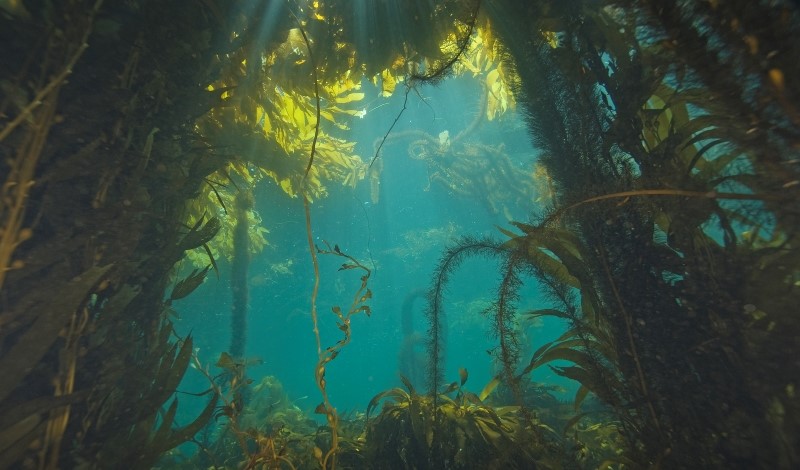
Scholars discuss ways for federal and local governments to combat harm to the ocean from climate change.
Oceans make up 71 percent of Earth’s surface and are vitally connected to the planet’s overall climate. Ocean waters, for example, absorb approximately 90 percent of excess heat produced by greenhouse gas emissions, protecting the planet from extreme temperatures.
The United States is the country with the second largest ocean territory, spanning over 4.4 million square miles. Yet experts contend that the ocean is too often overlooked in climate change policy conversations. Businesses and conservation organizations have called for the adoption of a federal ocean climate policy in the United States, specifically to leverage the ocean’s ability to mitigate the effects of climate change and promote environmental justice.
Earlier this year, the Biden Administration announced the first-ever federal climate plan for oceans. The plan describes actions and regulations to support healthier oceans: creating a carbon-neutral future, promoting nature-based solutions, and facilitating community resilience to climate change.
Oceans currently face numerous threats. Researchers at the United Nations consider overfishing to be the largest threat to oceans, noting that exploitive fishing practices reduce biodiversity and deplete resources for future generations. For example, the population of commonly pursued fish in the ocean has decreased by 90 percent since industrial fishing began.
In addition, ocean acidification caused by excessive amounts of carbon dioxide in the atmosphere poses a major threat to oceans. Changes to the ocean’s overall health in turn threatens global food security by destroying coral reefs, causing unnatural fish migrations, and diminishing the absorption of greenhouse gases.
Advocates of a U.S. ocean policy argue that federal agencies should mobilize regulators in coastal states to implement regional protections. Activists also recommend that the government prioritize environmental justice by consulting Indigenous peoples and communities unduly impacted by adverse climate effects.
In this week’s Saturday Seminar, The Regulatory Review summarizes the work of scholars and other experts who offer varying perspectives on the relationship between climate change and the planet’s oceans.
- Ocean acidification caused by climate change is the most significant long-term threat to ocean health argues Robin Kundis Craig of the University of Southern California Gould School of Law in an article in the Stanford Environmental Law Journal. Nutrient pollution, caused by excess fertilizer flowing into the ocean, and atmospheric deposition, such as the burning of fossil fuels, increase nutrient concentrations in the ocean, Craig explains. According to Craig, this increase in nutrient concentrations commonly causes algal blooms, which consume oxygen and choke out other species, leaving dead zones. Although the Clean Water Act and state regulatory programs have addressed some of the sources of nutrient pollution, Craig argues that these existing approaches need to be more aggressive. Craig advocates policies take a systems approach to reducing marine nutrient pollution.
- In an article published in Conservation Letters, Steven J. Dundas of Oregon State University and several coauthors propose climate change solutions that include both terrestrial and ocean-based climate solutions, a strategy they call the “Teal Deal.” The Dundas team offers action steps in four sectors: renewable energy, transportation, food security, and habitat restoration. As a next step, Dunas and his coauthors suggest that policymakers develop market-based mechanisms, such as emission trading programs and bunker fuel levies, to fund terrestrial-ocean solutions. They point out that market-based solutions can be cognizant of social inclusivity and may contribute to long-term sustainability by providing economic empowerment to communities that are disproportionately impacted despite their minimal contribution to climate change.
- Regional collaboration is critical to the development of a national ocean policy, suggests Brion Blackwelder in an article in the Tulane Environmental Law Journal. Blackwelder argues that regional plans can put pressure on federal decision-makers to act in marine territories that are outside of states’ jurisdiction. These regional plans could benefit from federal cooperation to extend their jurisdiction nearly 200 miles offshore, explains Blackwelder recommends that the national ocean policy take the form of a bipartisan, state-federal partnership that supports successful regional collaborations. A legislatively created national ocean policy, Blackwelder emphasizes, would allow regulators to respond quickly to ocean crises such as toxic red tides and invasive species, instead of abandoning states in times of need under what he describes as an existing piecemeal approach to management of critical natural resources.
- One solution to ocean acidification would be for states to implement restorative ocean farming because it improves water quality, according to Tara A. Pierce in an article in the Hastings Environmental Law Journal. Given the rapid decline in marine biodiversity, Pierce further argues that states cannot afford to wait for federal legislation and should follow the contours of California’s ocean acidification reduction strategy as a guide to effective regional cooperation. California’s policy identifies shared priorities with neighboring states, explains She emphasizes that the establishment of restorative ocean farms demonstrates a departure from a resource extractive policy approach in favor of a beneficial relationship between humans and their habitat.
- In a policy memo published in Urban Open Lab, Madeleine Traynor of Columbia Climate School and several coauthors examine the regenerative ocean farming industry in the United States, focusing on challenges facing individual farmers and the industry as a whole. Some of these challenges include inconsistent permitting processes across state and local governments, a need for improved food safety regulations for ocean farming products, and a lack of a comprehensive federal regulatory framework for offshore agriculture. At the local level, Traynor and her coauthors recommend that governments invest in waterfront infrastructure, provide funding to farmers, and develop information networks between farmers, stakeholders, and the public. Traynor and her team suggest that state governments provide equitable funding to new farmers and develop policies to protect workers’ rights and Indigenous communities.
- In an article in the Yale Journal on Regulation, Robin Kundis Craig of the University of Southern California Gould School of Law argues that focusing on marine aquaculture as a potential climate change industry would provide federal agencies, coastal communities and tribes with the opportunity to set standards for beneficial forms of marine aquaculture before the fishing industry implements less helpful practices. According to Craig, the benefits of the marine aquaculture industry are ignored under current regulatory policy. Marine aquaculture directly advances climate change mitigation by improving water quality, which minimizes stressors on the marine ecosystem, such as reducing the possibility of algal blooms, Craig finds.
The Saturday Seminar is a weekly feature that aims to put into written form the kind of content that would be conveyed in a live seminar involving regulatory experts. Each week, The Regulatory Review publishes a brief overview of a selected regulatory topic and then distills recent research and scholarly writing on that topic.



